I Love Cliff Swallows!
What started as curiosity about why the swallows didn’t return to Mission San Juan Capistrano turned into a deep appreciation of these incredible little beings. Some of my most joyful moments are spent just watching the swallows live their lives as exceptional parents and community members.
“The Swallows of Capistrano” (2000) was my first production. It’s about 30 minutes long and begins by exploring the relationship between Mission San Juan Capistrano and the swallows. After the swallows left the mission, they moved to Saddleback College – just up Trabuco Creek from the mission. The video concludes by following the swallows through their season – returning to the colony and raising their families.
The production won Honorable Mention Communicator awards in the categories of Environment and Music Scoring. Thanks to Ruben Ortiz and Sajama (SajamaMusic.com)! Their music was perfect for the swallows! And since I had just learned to shoot and edit, I was pretty happy with my first production!
I also cut three video montages that are set to Sajama music tracks: Welcome Home, Raising a Family, and The Season which combines footage from the other two montages. Just swallows and Sajama music. My favorite.
ALL ABOUT CLIFF SWALLOWS
Once a teacher, always a teacher. Here’s a link to a page where you will find lots of information about cliff swallows and a pdf download. Go to All About Cliff Swallows. Enjoy!
THE MAKING OF “THE SWALLOWS OF CAPISTRANO”
In 1998, I didn’t know anything about swallows. But I figured that if I wanted to learn about them, all I had to do was go to Mission San Juan Capistrano on Swallows Day and they would be there.
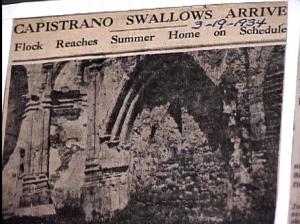
After all, the swallows were world famous for their annual return to the mission. Even a song had been written about them – “When the Swallows Come Back to Capistrano ” – and were a symbol of enduring love.
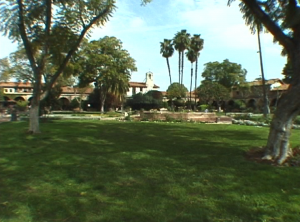
So I visited Mission San Juan Capistrano on Swallows Day (March 19), all ready to celebrate the return of the world-famous swallows.
The swallows are SO famous that the City of San Juan Capistrano closes its streets and hosts the Swallows Day Parade – the largest non-motorized parade in the United States. All to celebrate these wonderful birds!
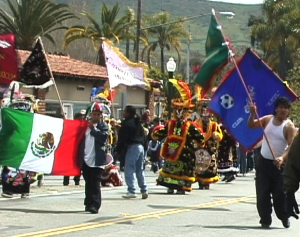
People come from all over the world to participate in the celebration.
I couldn’t wait to see the swallows!
The crowds grew inside the mission.
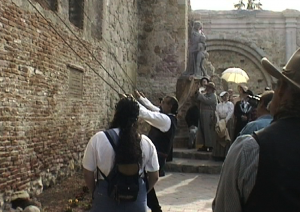
Mission bells were rung, the incredible group Sajama played, Mariachi bands played, Aztec dancers danced, beautiful people in period costumes roamed the Mission grounds, and the Kettle Corn was great. News crews and reporters were there. Huell Howser and Louie were there.
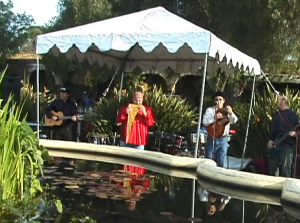
I was excited! I was going to see the swallows!
We all waited in great anticipation. All day.
No swallows.
What was up with that?
The official story was that the swallows had, in fact, returned to the Capistrano Valley. And if you looked really hard, you could see them flying overhead. Tiny little specks in the air swooping and feeding on insects.
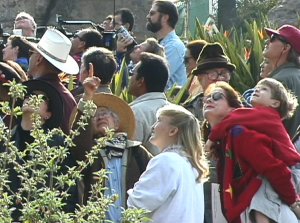
That didn’t seem like enough to justify Mariachis and a parade, so I was determined to find out what was up with the swallows.
SO WHAT WAS SWALLOWS DAY ALL ABOUT?
Some visitors to the Mission that day remembered what Swallows Day was all about – and they were glad to share.
First of all, the swallows celebrated by the Mission are cliff swallows. Before there were human structures, these swallows built mud nests on the faces of cliffs.
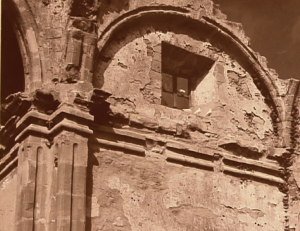
When the Great Stone Church fell in an earthquake in the early 1800s, the swallows took up residence in the ruins.
What a perfect place for a colony – protected by the elements, lots of insects to eat over the creeks and grasslands, and nearby sources of mud for nest building. Over the years, the colony expanded to hundreds of nests throughout the Mission grounds.
But what was up with Swallows Day?
People who remembered what it was like talked about the swallows “darkening the sky” above the Mission at sundown. They told of the swallows flying in a huge swarm, calling to each other, getting lower and lower in the sky, until they finally flew into their nests for the night – right over the heads of excited visitors. People would scream and cheer – and celebrate.
The nests that had been empty since the previous fall were full again. Spring had arrived, along with the promise of new life and new beginnings. That’s what Swallows Day was all about.
WHAT HAPPENED TO THE SWALLOWS?
The answer was pretty simple: No nests, no swallows.
In 1991, the Mission had to remove all of the swallows’ nests to accommodate earthquake retrofitting – procedures necessary to stabilize the crumbling structure.
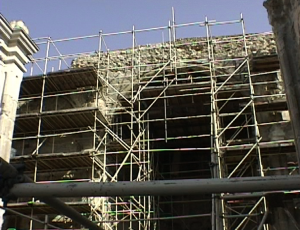
Can you imagine returning from vacation and finding that your entire city had been wiped out?
The swallows did what we would do: rebuild.
WHERE DID THE SWALLOWS GO?
In the spring of 1998, I enrolled in an environmental studies class at Saddleback College – just up the creek from the Mission, as the swallow flies.
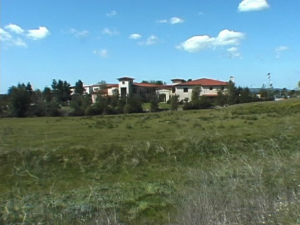
Guess who was there? Instead of rebuilding their colony on the Mission grounds, the swallows went a few miles up the creek and started over at Saddleback Community College. There were hundreds of nests – all full of swallows.
Unfortunately for the swallows, Saddleback Community College was not happy with their new residents and attempted to deter them. Some strategies proved fatal to the swallows. One year, their wings were glued. Another year, swallows perished inside improperly installed netting. Nets were put, covering the existing nests. The swallows could see their nests, and were able to find their way through the netting. But they could not escape. Hearing the distress calls, other swallows found their way inside the netting to try to help, but ultimately, many perished, unable to escape.
My only act of civil disobedience (so far …) was to tear some netting down to free the trapped swallows. (I’m proud of that.)
Swallows are protected by the Migratory Bird Act, and many students and faculty members filed complaints with the regulatory agencies. The college was fined, but the damage was done.
WHAT WAS I GOING TO DO?
There are times in you life when you feel called to action, but you don’t know what to do. Liberating the trapped swallows was a good start, but it was not enough.
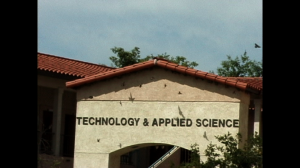
The answer came. The Environmental Studies class I was taking at the time covered different conservation stategies, and the one I was most familiar with was the “charismatic megafauna” approach used by Charles Munn – identify an attractive species (like a rainforest macaw), show how beautiful it is, focus on its protection and you end up protecting all the species in its territory that are not so attractive (amphibians, insects, etc.). Cool.
I wasn’t trying to protect an ecosystem, but I thought that by documenting the beauty of the cliff swallows, some people might fall in love with them (like I did), or at the least, it might make people more tolerant and less likely to want to kill them.
I learned everything I could about cliff swallows. The world’s cliff swallow expert is Charles Brown, University of Tulsa, and I read his books and many of his research publications.
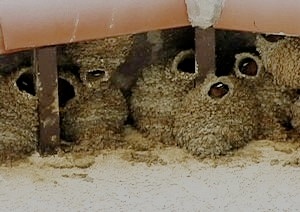
I bought a camera, learned to edit, and over the spring and summer, I documented the lives of the Saddleback Community College colony. There were 450 active nests that summer – what an exciting time! (And I have over well over 60 hours of “swallow cam” footage to prove it!)
As the project got bigger, I included footage from the Mission’s Swallows Day celebration, interviews with author, Gloria List, and long-time valley resident, Paul Haven.
And I got permission from Ruben Ortiz of Sajama (SajamaMusic.com) to use their music tracks in the production. What a blessing! Nothing says swallows to me like pan flute and Chilean music!
I even got my grandmother, Jacqueline Petersen, involved in the project. It turns out that my great-grandmother’s birthday was March 19 (St. Joseph’s Day), and from her home in the midwest, she loved hearing about the swallows and always dreamed of someday visiting the Mission to see them.
Coincidence? I think not.
ANOTHER SWALLOWS DAY AT THE MISSION
The project was finished in 2000 and Swallows Day was approaching once again. I decided that I wanted to show clips from my video at the Mission during the Swallows Day celebration, so that Mission visitors could see what the fuss was about. And maybe sell a video or two. I spent Swallows Day at the Mission each year from 2000 until 2005.
With approval from Mission administration, I set up a booth – my first experience with retail. (Yikes!)
I also handed out material about the swallows – The Cliff Swallows of the Capistrano Valley. (Once a teacher, always a teacher.) And I gave Mission visitors directions to Saddleback College. After all, people had come to the Mission wanting to see swallows! And they were so close!
And I met amazing people who had deeply touching stories about how much the swallows meant to them. Stories about plans to visit the mission to see the famous swallows – sometimes years in the making. Couples in their golden years who finally made the journey. People who always wanted to celebrate their birthday with the swallows. People who remembered the magic of the swallows from their childhoods. The stories were endless.
I was always thrilled as people shared their stories and watched the video – the light on their faces, their joy. It went beyond age, culture, time, and language. There’s nothing like it.
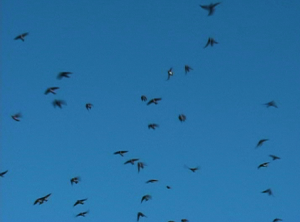
At dusk, after the Mission closed, I went to visit the colony. Lots of Mission visitors were always there. We looked like the scene from “Close Encounters of the Third Kind” – scanning the skies, waiting for something magical to appear. We were never disappointed. We watched as the swallows swarmed and chattered and flew above our heads into their waiting nests.
All was right with the world. It just doesn’t get better than that.
WILL THE SWALLOWS EVER RETURN TO THE MISSON?
Only the swallows know. But to maximize the chance of their return, former Mission administrator, Gerry Miller, brought expert, Charles Brown, to the Mission to consult and develop a plan.
According to Dr. Brown, the best way to attract swallows back to the Mission would be to construct at least 100 artificial nests and install them on the ruins of the Great Stone Church – the center of the former colony. When the migrating swallows returned, it would appear as if a successful colony already existed at the Mission.
But that might not be enough. He also recommended broadcasting the swallows’ swarming calls through loudspeakers at dusk, which would get the attention of the returning swallows.
Because swallows would rather occupy existing nests than build new ones (such hard work!) the artificial nests and swarming calls would act like a giant “Vacancy” sign. And maybe some curious swallows would investigate and move in.
Dr. Brown’s research found that swallows will definitely use appropriately constructed artificial nests, but not all manufactured swallows’ nests are deep enough. (They are decorative, but the swallows won’t use them.)
To begin the restoration process, Dr. Brown sent sample swallows’ nests to use as molds for artificial nests, and I sent audio of the swallows’ swarming calls to Dr. Brown. He reviewed the tapes and suggested the best sections to use. (The sections with no alarm calls. Duh!)
Will the Mission implement the plan? Only the Mission knows.
Will the swallows spontaneously begin nesting at Mission again? Only the swallows know.
ENJOY THE SWALLOWS
Wherever you are, if there is a swallow colony nearby, go visit it. You will see what has inspired generations before you – and will continue to inspire generations to come.
